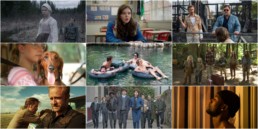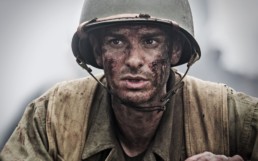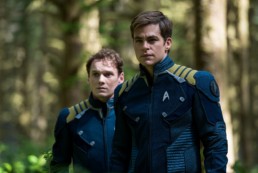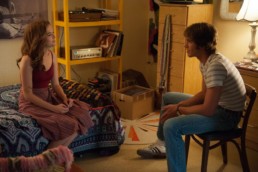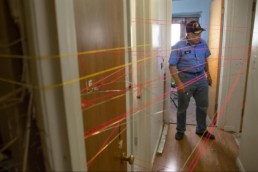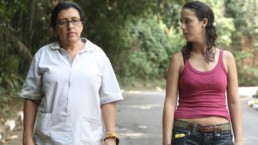Jared's Top 10 Films of 2016

A joint tenth place; but come to think of it, "Captain Fantastic" and "Hunt for the Wilderpeople" succeed for a lot of the same reasons. Both are family tragicomedies that demonstrate incredible tonal sleight of hand, flowing from humor to pathos with ease. Both are, also, adventure films with incredible cinematography of their characters' forested habitat as they navigate odds with an unfamiliar outside world - much of their thematic makeup comes from understandable conflict with an unfamiliar modern world. And both feature commanding young actors alongside a never-better performance from a veteran actor most commonly associated with a popular film trilogy (Viggo Mortensen and Sam Neill, respectively).

The sole documentary entry on this list, "Life, Animated" is a testament to how the power of motion pictures can never to be underestimated. It is a biography of Owen Suskind, a movie theater attendant in Cape Cod, Massachusetts. But his backstory, with no shortage of adversities and triumphs, is a magnificent account of creativity and the human spirit. The use of illustrations to depict Owen's struggles make for perhaps the most memorable portrayals of Autism on film, but also of how art can help us all contextualize the world and learn to connect with it in new ways.








Honorable Mentions:
Deadpool.
'Hacksaw Ridge' Review: In Beautiful Yet Brutal a Pacifist Goes to War
Before the first bullets are even fired, it seems like we've already seen enough. And once they fly, Hacksaw Ridge unleashes a vision of war worthy of comparison to Saving Private Ryan or Come and See.
When it came out in 2004, The Passion of the Christ instantaneously became one of the most surreal pop culture events of the 21st century. An antagonistic, foreign-language psychological drama from an independent studio became the film everyone was talking about and, eventually, the biggest R-rated film of all time - a title it retains here in the States. The film's noteworthy intersection of deism and masochism, it turns out, was the ultimate motif of Mel Gibson as a director.
His previous effort, Apocalypto, has to be the most esoteric, daring, and perverse film ever distributed by Buena Vista - and also one of his signature unhinged historical epics. A decade later, however, the prospect of a new film from the Mind of Mel doesn't exactly inspire nostalgia. Being one of the definitive figures of Bush-era zeitgeist is one thing; another matter entirely was his public fall from grace, which needs no recap here. Regardless, the original Mad Max himself finds his way back to the director's chair with Hacksaw Ridge, and in doing so reunites with screenwriter Randal Wallace and the thematic territory of martyrdom.
The film recounts the story of Desmond T. Doss, an American medic during the Battle of Okinawa who was known for refusing to bear arms - even in the heat of battle - which lead to his status as the first conscientious objector to receive the Medal of Honor. Doss's peculiar case of pacifism and Seventh Day Adventism made him an unlikely hero of World War 2, but his perspective provides a unique framework for the blood-soaked Gibsonian aesthetic.
https://www.youtube.com/watch?v=s2-1hz1juBI
If it weren't for the in medias res opening shots, the first half hour of mildly clichéd Greatest Generation melodrama might imply a subdued rehabilitation for the notorious character behind the camera. There are some highlights to this stage of the film, especially with Andrew Garfield's Doss as such a hearty presence. The supporting cast includes Vince Vaughn in an admirable R. Lee Ermey homage, and a couple of Gibson's fellow Australians: a tragic turn by Hugo Weaving as elder Doss, and Sam Worthington, for whom Army Captain is a natural fit.
Halfway through, it's clear Gibson has in fact retained his appetite for destruction through his exile. The initial foray into the Pacific Theater echoes the way his camera slowly marched into the belly of the Mayan empire in Apocalypto. The anxiety begins with the foreboding image of cadavers and the thousand-yard stare in a retreated soldier, yet Gibson masterfully winds us up even more upon Doss's battalion entering the battlefield. Before the first bullets are even fired, it seems like we've already seen enough. And once they fly, Hacksaw Ridge unleashes a vision of war worthy of comparison to Saving Private Ryan or Come and See.
If anything, Gibson's depiction of this hell-on-Earth is more persuasive sermonizing than any petty, politicized paranoia demonstrated by the likes of God's Not Dead. Yes, this is ultimately a film about and conceived by a sense of religious conviction, yet it is not designed with exclusivity as The Passion was. The juxtaposition of the most violent film in recent memory with its nonviolent hero prompts challenging questions about the authority and compromise of morals, regardless of worldview.
There are misjudged moments that may serve to reinforce Gibson's reputation. The one that comes to mind is an obligatory montage of the enemy's surrender towards the end that is filmed in a questionable manner as the Japanese military go down in a blaze of gratuitous self-immolation. It is not without these moments of the tacky and the trite, but Hacksaw Ridge is an effective war drama and reintroduction to its helmer's lyrical brutality. There remains significant doubt that a sequel to Passion is what the world needs.
"Hacksaw Ridge" is rated R for intense prolonged realistically graphic sequences of war violence including grisly bloody images. 2 hours 11 minutes. Now playing in select cities.
Review: Antoine Fuqua's Remake of 'The Magnificent Seven' Might Be the Best of the Summer
The 21st-century take on The Magnificent Seven comes at a time where the Western has been subsidized by Hollywood though not quite at the level it once was. Numerous DiCaprio and/or Tarantino vehicles have made stabs at bringing it back to life, each with critical success but to varying degrees of the commercial kind. This remake, then, might be exactly what the genre needs right now: a muscular yet accessible action adventure that might be more palatable to a general audience than the exhausting tension offered by last winter's double feature of The Hateful Eight and The Revenant.
To those uninitiated with the general story (after all, this is a remake of a remake), this is an entertaining introduction to these tropes by a man who knows his way around an action movie, Antoine Fuqua. The villagers of a small town enlist the help of outsiders to repel the forces of corruption and oppression, and they do so by biting the the bullets of a hundred triggers. Fuqua sheds the extraneous silliness that marred Olympus Has Fallen and The Equalizer, which yields a leaner action film that nonetheless retains the fun catharsis of his previous shoot 'em ups.
The premise demands an excellent ensemble cast, to which this Seven certainly answers the call. Denzel Washington and Ethan Hawke, the two leads from Fuqua's most acclaimed film, Training Day, are reunited on screen and their subdued, world-weary performances are the glue that holds this gang together. Arguably though, the biggest scene-stealers are Chris Pratt and Vincent D'Onofrio (this pair reunited from last year's Jurassic World). Pratt is comfortable playing variations of a same character between his biggest films, which is the endearingly cocky persona that always suits the environment of the picture - a virtue matched by the big names that he continues to ascend towards, such as Will Smith or Harrison Ford. D'Onofrio contributes an unhinged, oddball performance that one could quite confidently say only he could do.
He's given roughly the same amount of screentime as the rest of the protagonists, which includes a bandito Manuel Garcia-Rulfo, dagger-happy Byung-hun Lee, bow-happy Martin Sensmeier, and the de-facto town leader played by Haley Bennet. That completes a diverse roster entirely welcome in the climate of 2016. Not only are these performances impressive in and of itself, but there's a rich chemistry between each of them that makes good use of the time in between the massive-scale battle sequences.
If you are familiar with the 1960 original (famous for starring Yul Brynner and Steve McQueen, among others) or perhaps Kurosawa's The Seven Samurai before that, this version does not reinvent the wheel - nor does it aim to. Fuqua's M7 is exactly what it should be: a rousing, old-fashioned good time.
'The Magnificent Seven' is rated PG-13 for extended and intense sequences of Western violence, and for historical smoking, some language, and suggestive material. 133 minutes. Now playing in theaters nationwide.
‘Star Trek Beyond’ is an Enterprising Addition to the Canon
When J.J. Abrams' first “Star Trek“ film came out in 2009, it connected with moviegoers just as “Casino Royale” and “Batman Begins” had earlier that decade. Each were successful bids to breathe new life into a long-standing pop culture mythology and reverently introduce it to a new generation.
Fast forward seven short years: while the Craig and Nolan eras of Bond and Batman (respectively) have expired, this reinvigorated movieverse continues. In between, we had “Star Trek Into Darkness,” which was the mirror image of “Quantum of Solace” - a frustrating, risk-averse sequel built on recycled parts. A franchise known for going "where no man has gone before" essentially spun its wheels.
Enter “Star Trek Beyond.” Abrams has relinquished the helm of this threequel to resuscitate the other long-standing Space Western juggernaut that is "Star Wars" (where his knack for narrative mystique is better served anyway, as the internet rages on about whom Rey's parents are). Rather, "Star Trek Beyond" is directed by Justin Lin, whose oversight in transforming the "Fast & Furious" franchise produced action adventures that championed the teamwork and diversity that's always been a staple of "Trek" ethos too.
Lin's color palette isn't as flaring, but like Abrams before him, he brings propulsive energy to the Star Trek universe. However, this film feels more obsessive and episodic, which is best explained by the upgrade in screenwriters to Doug Jung and, one of the film's stars, Simon Pegg. The first two films approached standard narratives of intergalactic warfare and vengeance, but “Beyond” opts for an orthodox story established in the original series vibe of voyage and discovery, as they encounter a new foe in Krall (Idris Elba).
Much of what did work in Abrams' films not only carries over but is improved. The banter between the new USS Enterprise cast is always a treat, and actors like John Cho, Karl Urban, and the gone-too-soon Anton Yelchin get more screen time. Everybody seems more comfortable filling such big shoes at this point, and Chris Pine especially steps up his game - before he was characterized as a cocky hothead, but his Kirk here is the wiser and more confident hero that older audiences will recall.
The film arrives on the 50th anniversary of Gene Roddenberry's franchise and offers no shortage of tribute to the original series and its cast, including the recently departed Leonard Nimoy and a winking reference to George Takei.
“Star Trek Beyond” is rated PG-13 for sequences of sci-fi action and violence. 2 hours. Now playing in theaters
'Sing Street' is a Cinematic and Musical Delight From the Director of 'Once'
Sing Street takes place roughly half a decade after the last film this writer reviewed, Everybody Wants Some. In both stories, the setting is somewhere in the Western Hemisphere, during the homestretch of the Cold War. In both stories, a group of adolescents come together in the name of fellowship, bonding over the pop culture of the time and a desire to break away from the tangible. And in both stories, at some point, Pop Muzik by M shows up in the background.
The more recent of the two films comes courtesy of Irish filmmaker John Carney, most well-known for grabbing the attention of the film world in 2007 with Once. His previous film, 2014’s Begin Again, was his first film made across the Atlantic pond. Now Sing Street sees him return to the streets of Dublin, where our protagonist Cosmo (Ferdia Walsh-Peelo, somewhat of a ringer for Freddie Highmore) enrolls at the local Christian Brothers school (at the whim of his father, played Aidan Gillen a.k.a. Littlefinger) where his passion for music is awakened by his older brother (Jack Reynor) and a desire to start a band to win the heart of the mysterious Ralphine (Lucy Boynton).
There is an element of autobiography here, not unlike how it was for Greg Mottola in Adventureland or Steven Chbosky in Perks of Being a Wallflower. John Carney’s own musical background does have a notable stint as bassist for the 90’s Irish band The Frames, a band led by his Once star Glen Hansard. Details such as his school’s insistence on black shoes are pages taken from his own life story, much like how Almost Famous reflected the advent of Cameron Crowe’s career in music journalism through the shy, blossoming music aficionado.
To that end, the story and character beats are conventional but organized delicately. This film is a little more innocent than those just mentioned, or even something like the amiable nostalgia of Everybody Wants Some. The catholic schoolboys of Sing Street are right at the onset of puberty, not yet so acquainted with the confusing realities of drugs, sex, mental illness, etcetera. Not to say that they aren’t troublemakers, but there’s a bright-eyed charm to everything they do.
Like in Begin Again, the musical landscape that the characters inherit has quite a verisimilitude. Carney loves to relate the characters’ musical lives to the way they live with everything else. The fertile era of 80’s post-punk and new wave is almost the ideal context in which to do this, with the multiple subcultures inspired by those sounds – punks, goths, mods, futurists, among others. The result is an ode to how music shapes identity; especially how it gives glory to being a misfit, an underdog, or a despairing romantic that otherwise might not exist. People tend to look at someone’s musical taste as part of a bigger picture; Cosmo's brother warns him that a woman can never truly loves a man that listens to Phil Collins, for instance. Sing Street is a film about discovering the music you want the world to judge you by.
Sing Street is rated PG-13 for thematic elements including strong language and some bullying behavior, a suggestive image, drug material and teen smoking. Now Playing.
'Everybody Wants Some!!' Is One Big Joyful Ride of Nostalgia
Everybody Wants Some!! is the second Paramount Picture in 5 years to feature "My Sharona" by The Knack. The fact that the other film is Super 8 tells you all that is needed about why a filmmaker chooses to put said song in the soundtrack. Obviously, it has partly to do with the setting (it's the end of the 70's, Sugarhill Gang have introduced rap into pop culture for the first time, and the Reagan Era is about to begin). But to use this song, in particular, is a declaration - that you're making a film that's meant to be nostalgic.
We're dealing with Richard Linklater here, a pioneer of American independent film along the likes of Steven Soderbergh and Quentin Tarantino. Similar to those directors, he's had his crossover successes with mainstream audiences, most notably 2003's School of Rock. While a film like that and much of his "art house" repertoire exhibit his dry directorial style, a common criticism of his filmography is a reliance on nostalgia. More specifically, it is an argument that any (inevitable) retro pop culture artifact or reference that appears in his movies solely exists to remind the audience that, say, Disco was once a thing. "Hey, remember this?"
It is true that between this newest project and his last, the notoriously epic undertaking of Boyhood, Linklater does indeed use the contrasts of then and now to his advantage. But these criticisms assume that this is an inherently cheap and manipulative tactic. The reality, however, is that these films possess a rare and unsung power to demonstrate how time has molded us and is continuing to do so. Nowhere else in the prolific filmmaker's catalogue is this more apparent than in the Before trilogy.
Whereas Boyhood explored a dozen different stages of youth and adolescence, Everybody Wants Some!! is content to focus on only one - coincidentally, it picks up where Boyhood left off: the last days before college. We spend most of the runtime with Jake (Blake Jenner), who is a new recruit in an amateur college baseball team deep in the heart of Texas. Jenner and the rest of the dudes (especially Expendables 3's Glen Powell) have impressive chemistry with one another. While the film is mostly concerned with the camaraderie of these young men, there's also a believable romance between Jake and chance encounter Beverly (Zoey Deutch). Their relationship provides few moments of heartfelt sincerity amidst the authentic raunch of the baseball fraternity-of-sorts.
It's after that last sentence one feels the need to distinguish Everybody Wants Some!! from the American Pie DTV sequels. Even in good teen sex comedies like Superbad, there's a harshness that is wisely avoided here. While the film's "heroes" are undeniably id-governed jocks, they are also... in a weird way... inclusive. Linklater has a gift for writing dialogue that is on the same wavelength as his characters, and it makes them endearing. In 2016, it's tempting to look at the manifestations of "bro" culture and consider it a source of regression. But through his colorful characters and - what else? - nostalgia, Linklater presents a time where masculinity didn't have to be unpleasant and bigoted. There are moments where Jake and the rest of the athletes find themselves at punk rock shows and thespian art school parties. Tourists? Perhaps. Posers? Not at all.
There's no plot or character conflict to speak of here; the film counts down to the first day of classes for our baseball heroes, but where it ends is anybody's guess. The film is one big joy ride, true to form for a film chronicling wild but decent Young Americans that have found themselves in the eye of the hurricane of change. At one point, a team member monologues about how he couldn't understand living any life where he doesn't end up playing professional baseball. The audience doesn't really need American Graffiti's ending tiles to figure out what ends up becoming of these guys. It didn't quite pan out that way.
Everybody Wants Some!! is rated R for language throughout, sexual content, drug use, and some nudity. Now playing in theaters everywhere.
Review: 'Peace Officer'
The day is September 22, 2008 – exactly 7 years ago today. A 911 phone operative receives a distress signal from a woman about her suicidal husband. What followed was a protracted standoff with an armed-to-the-teeth police force and the aforementioned man trapped in his truck with a pistol. The encounter lasts 12 hours, and ends with a yielding suspect being subject to non-lethal rounds, 6 flashbang grenades, and ultimately a fatal sniper round. The Farmington, Utah police force’s first instinct is to tell the wife that her husband had killed himself. The documented video footage of this event is presented right before the opening title of Peace Officer rolls.
One of the most immediate things to hit when watching Brad Barber and Scott Christopherson’s documentary is how impeccably researched it is. The film gives a comprehensive overview of police militarization in the United States, starting with the Watts riots here in Los Angeles up until the more recent and literal sense of the word militarization: we see outdated equipment and vehicles from prior wars “trickle down” into middle America neighborhoods, which is as unsettling to see as it sounds. We’re then shown a handful of cases within the state of Utah wherein the police used unnecessary, questionable, sometimes even trigger-happy tactics. In many of these scenarios, tactical teams inexplicably decide not to announce themselves.
'Peace Officer' is a relevant and challenging documentary, yet just like its protagonist in Dub Lawrence, it’s one that’s clear-eyed enough to offer solutions to the problems it addresses.
Barber and Christopherson’s main subject is William J. “Dub” Lawrence, a man who holds the record for youngest sheriff in the Davis County of Utah. Beyond this statistic is a seasoned public servant with a unique perspective to the trends in law enforcement power. Lawrence initiated the first active SWAT team in his jurisdiction, but has since bore witness to the extreme tactics that led to that fateful September 22 day when his son-in law happened to be the victim.
It’s hard to imagine a better guide through the concerns of police militarization than Lawrence. Whether he’s re-examining crime scenes to debunk hackneyed police investigation work, campaigning for change in Salt Lake City, or at his own headquarters “self-medicating with work”, he’s an endearing figure because he has goals. He hopes for a day where the modern police unit can return to the status of a “qualified, trained, peace officer” that he remembers when he first took office. Despite whatever personal suffering Lawrence has incurred, he is a man of clear conscience and empathy.
Peace Officer features subjects who can frame their arguments in an intelligent manner. And it’s not just Lawrence; the journalists and scholars interviewed, for example, strip the subject of police brutality to its core – none of them have much time to confront the controversial comorbid factors such as racial discrimination. The most poignant point made here is that the violence is often avoidable, but it ultimately comes down to millisecond reactions on both sides.
The film is also heartbreaking when we see the confused enmity of interviewed police officers, whose grief and guilt are often visible when discussing policemen who have fallen to friendly fire. The same can be said when we see the families of victims are interviewed – these are people who have become so disillusioned with law enforcement that they firmly belief officers don’t know “what they’re protecting the people from” anymore. Peace Officer is a relevant and challenging documentary, yet just like its protagonist in Dub Lawrence, it’s one that’s clear-eyed enough to offer solutions to the problems it addresses.
Peace Officer is now playing at the Nuart Theater in Los Angeles.
https://vimeo.com/118632574
Review: 'The Second Mother'
The Second Mother is set in Sao Paulo, where Arcade Fire is referred to as “The Arcade Fire”. The story follows the eponymous character Val, a housekeeper for a considerably wealthy family, and it’s not an understatement to say her job has become her life. When her daughter Jessica flies into town, the duo end up staying in the house. The main conflict herein is Val’s struggle to identify with a daughter she never quite got to raise. At one point she even relies upon the opinion of the family’s son to get a sense of what her own daughter is like.
Now this is a mostly quiet picture. Music is scarce, and camera angles slowly move if they aren’t static. Scenes within the house are almost claustrophobic due to how these angles repeat themselves throughout, mirroring the routine of Val's life. Aside from one sequence set in a high-rise, the surrounding city is never really explored (except for that it rains a lot). But these elements make the film contained, focused, and even intimate in its storytelling.
Regina Casé shines in the lead role. She is a graceful presence as an immediately empathetic and cordial character.
It must be said, Regina Casé shines in the lead role. She is a graceful presence as an immediately empathetic and cordial character. Val is visibly frustrated by her position – she overthinks how to organize a new coffee table set, is bothered by the family dog, and can’t seem to stop Jessica from eating the family’s chocolate ice cream. Everybody in The Second Mother seems perpetually frustrated and vicariously argumentative. This feeds what is most interesting here: the dynamics and dialogues between characters.
This is a film primarily about thickness of bonds, how we concern ourselves with the opinions and approvals of those outside our family, and how they seem to mean more when they are earned. The family’s son reaches out to his second mother over his first for this reason. But the film is moreover a character study about Val’s shortcomings as a first mother herself. That said, while the movie is more dramatic than comedic, it has a natural levity that lends itself to a something deeply felt but also feel-good.
The Second Mother opens this Friday in select Los Angeles theaters.
https://www.youtube.com/watch?v=SOrbWcObwR4

